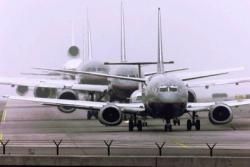I’ve invited you here this afternoon to update you on one
of our top safety initiatives. Safety does remain our primary
focus, and we will not allow the distractions of the day to keep us
from the work at hand.
Our safety record on both fronts -- commercial and GA -- is
nothing short of unprecedented. And a lot of it has to do with the
work that goes on every day in this building, and around the
country, by our technicians, controllers, inspectors, and
engineers.
With that in mind, I’m pleased to announce that we
continue to move the chains forward on a pressing matter —
runway safety. You’ll recall that last August, we issued a
challenge — a call to action to our industry partners that we
need to step it up to make runways safer. And they’ve
responded like never before.
 We’re almost
halfway through the year. So far, we’ve had 14 serious runway
incursions since the fiscal year started back in October. Only
three have involved a commercial air carrier.
We’re almost
halfway through the year. So far, we’ve had 14 serious runway
incursions since the fiscal year started back in October. Only
three have involved a commercial air carrier.
There were no deaths or injuries. And 14 is a tiny fraction
considering the millions of takeoffs and landings that have gone on
in that span. A passenger would have to board a U.S. commercial
flight every day for 10,470 years before having the probability of
being involved in a serious runway incursion.
Knowing that, it hardly sounds like it’s time to push the
panic button, but it’s still too many. And, as the aviation
safety agency, we can’t be satisfied even with numbers this
small. And the thing about incursions is — they are
preventable in almost every instance.
Our call to action included a top-to-bottom review of 20
airports. It uncovered a valuable amount of data — data
that’s led to more than 100 fixes. Some of them were as
simple as improving the markings and paint on taxiways.
Eighteen of those 20 airports are commercial. What’s
interesting to note is that there hasn’t been a serious
incursion at a single one of those commercial facilities so far
this year. To put that in perspective, those 18 accounted for 33
percent of all serious incidents last year.
Based on the success of that first batch of airports,
we’re now going to review 22 more facilities.
Moving west to east, among the airports included will be
Sea-Tac, Midway, and LaGuardia, Dulles and Teterboro.
 We’re
concentrating on the busy East Coast because that’s where the
action is. Of our initial review of 20 airports, eight were on the
East Coast. In this latest round, there are seven of them.
We’re
concentrating on the busy East Coast because that’s where the
action is. Of our initial review of 20 airports, eight were on the
East Coast. In this latest round, there are seven of them.
While LAX has been our single-most problematic airport, the
major airports on the East had 66 percent more serious incursions
than their counterparts on the West Coast last year.
To complement the efforts of our airport runway safety action
teams, I’d like to talk a bit about our technology
programs.
The NTSB has long advocated technology that provides a direct
warning to pilots in the cockpit. And, while we’re not there
yet, we are getting close with technologies like ADS-B. And, some
of you may have seen the announcement today about Jeppesen’s
certification approval of an “own-ship” moving map
display.
To help us better analyze the benefits of current cockpit runway
safety technologies, the FAA intends to make available up to $5
million to enter into cost-sharing, cooperative agreements with
industry.
It’s a public-private partnership at its best. And
it’s in the formative stages at the moment, but the aim is
for the operators and manufacturers to outline what they would do
with the funds to improve runway safety through the installation of
technologies like cockpit moving map displays, the runway advisory
warning system, ADS-B, and others.
We’re tentatively focusing on the New York-Florida
corridor since that’s where our congestion and NextGen
activities are primarily focused as well.
The data that we glean from these technologies will help us
better target safety trends and human factors issues to give us the
big picture that we simply don’t have yet. More to come on
this later in the summer.
We’re also spreading the net of safety well beyond the big
airports. We are looking into ways to bring affordable ground
surveillance radar systems to small and medium airports. These are
places where ground monitoring systems like ASDE-X, which can cost
more than $20 million, might not prove to be a sound financial
move.

We have two low-cost surveillance systems in testing at
Spokane.
The FAA has recently begun to identify other commercially
available, low-cost systems that might fit the bill, and to see
where they could be installed and tested. We’ve just
completed a market survey to identify potential industry partners,
and eight companies have stepped forward.
We expect to award contracts for the pilot project this fiscal
year. Additionally, we plan to have some of these products on the
ground and under evaluation at about six airports in fiscal 2009.
These systems will directly benefit the controller workforce with
increased situational awareness.
Likewise, we’re moving ahead with another important
technology — runway status lights. It’s an alert
warning system with red lights embedded in the pavement to warn
pilots to hold right where they are. This measure will
significantly boost runway safety without reducing capacity or
adding to controller workload.
The reasoning behind runway lights is simple. Drivers have stop
lights to guide them. Why not pilots?
DFW and San Diego already have them. LAX is up next. And stay
tuned for an important announcement soon about airport #4.
It’s our hope that by 2011, at least 20 airports will have
them.
Toward that end, the FAA has begun the process of inviting
companies to present proposals for a national rollout of runway
status lights. Expect an announcement by this summer on who gets
the contract.
 But technology itself
isn’t the only answer to a safe runway. It’s not going
to make incursions disappear overnight. We also must focus on the
human factor. One of those factors that sometimes surfaces is
fatigue. Tired people are more apt to make mistakes. Everyone knows
that.
But technology itself
isn’t the only answer to a safe runway. It’s not going
to make incursions disappear overnight. We also must focus on the
human factor. One of those factors that sometimes surfaces is
fatigue. Tired people are more apt to make mistakes. Everyone knows
that.
Whether it’s fatigued pilots, controllers, mechanics, or
anyone else, we want to work with the industry to discuss the
problem and find possible solutions.
So, we are going to sponsor a first-ever symposium dedicated
solely to the issue of fatigue.
We’re dedicating three days in June, the 17th, 18th and
19th, and it’ll take place here in the Washington area.
I’ll be there, along with a number of experts to discuss the
latest scientific evidence and best practices.
As you can see, we’re not letting up on the safety front.
We relish the challenge of finding ways to make a safe system even
safer. In short, we’re engaged and we’re moving
forward.
At this point, I’ll turn things over to my colleagues to
elaborate a little more on what we’re doing.
Thank you.
 ANN's Daily Aero-Linx (04.13.24)
ANN's Daily Aero-Linx (04.13.24) ANN's Daily Aero-Term (04.13.24): Beyond Visual Line Of Sight (BVLOS)
ANN's Daily Aero-Term (04.13.24): Beyond Visual Line Of Sight (BVLOS) Airborne 04.09.24: SnF24!, Piper-DeltaHawk!, Fisher Update, Junkers
Airborne 04.09.24: SnF24!, Piper-DeltaHawk!, Fisher Update, Junkers Aero-News: Quote of the Day (04.14.24)
Aero-News: Quote of the Day (04.14.24) ANN's Daily Aero-Term (04.14.24): Maximum Authorized Altitude
ANN's Daily Aero-Term (04.14.24): Maximum Authorized Altitude







